ILDA
The ILDA term is an acronym for the International Laser Display Association. ILDA is the trade organization that sets the Industry Standards for Entertainment Laser Shows. They do everything from promoting a better understanding between laser display professionals and regulatory agencies to setting the technical standards for the ILDA connector on the back of your Laser Projector plus much more.
ILDA LASERS (UNDERSTANDING THE ILDA CABLE)
The ILDA cable is a "D"-shaped DB-25 connector with 25 pins/wires that sends signals from a laser show controller to an ILDA controlled laser projector. The parallel port on most computers uses a DB-25F female connector. You can purchase DB-25 connectors, cables and switch boxes at most computer and electronics stores. This wide availability is one reason that ILDA chose the DB-25 for its ILDA Standard Projector connector.
| Signal name | Pin | Notes |
| X+ | 1 | -5 to +5V |
| Y+ | 2 | -5 to +5 V |
| Intensity/Blanking+ | 3 | 0V to +5V |
| Interlock A | 4 | Should be used in Interlock loop |
| Red+ | 5 | 0V to +5V |
| Green+ | 6 | 0V to +5V |
| Blue+ | 7 | 0V to +5V |
| Deep blue+ | 8 | 0V to +5V |
| Yellow+ | 9 | 0V to +5V |
| Cyan+ | 10 | 0V to +5V |
| Z+ | 11 | Depth Z (not intensity), -5 to +5V |
| Not connected | 12 | |
| Shutter | 13 | 0V to +5V (referenced to pin 25) |
| X- | 14 | -5V to +5V |
| Y- | 15 | -5V to +5V |
| Intensity/Blanking- | 16 | 0V |
| Interlock B | 17 | Should be used in Interlock loop |
| Red- | 18 | 0V |
| Green- | 19 | 0V |
| Blue- | 20 | 0V |
| Deep blue- | 21 | 0V |
| Yellow- | 22 | 0V |
| Cyan- | 23 | 0V |
| Z- | 24 | -5V to +5V |
| Ground | 25 | Common ground and Cable shield |
* NOTE - While the ILDA laser connection and ILDA cable has been common in the laser light show industry for many years, it also has limitations.
- ILDA cable can be difficult to run, due to its size, weight, and the "bulkiness" of the cable itself.
- As a result, when performing with multiple laser projectors, running large amounts of ILDA cable can be a nuisance.
- The ILDA cable is also only recommended to be run a maximum of 150ft.
- After 150ft, it can loose signal (especially in lower quality laser systems) thus resulting in a lower quality output resolution.
LASER SHOW PROJECTOR
To provide a simple definition, a laser projector is any laser system which projects laser output for entertainment purposes. Most entertainment laser show projectors have one or more internal laser sources (generally a combination of RED, GREEN and BLUE), which are then combined with an optical scanning system and various drive electronics, to allow for the display of 2D or 3D laser content and objects.
Laser show projectors are controlled in a few different ways...
ILDA Laser Show Projectors - These systems have a standard ILDA connector on the back of them, and can then be controlled using an ILDA compatible laser control system (which includes both ILDA laser show software, and ILDA laser control hardware). ILDA laser projectors provide a great degree of control over the type of laser shows you can perform, by allowing you to create laser show content in software, and then play it back from the laser show projector via laser control hardware (using a DAC - or digital to analog converter).
- Two good examples of industry standard ILDA laser control hardware, are the FB3QS and FB4.
-
FB3QS is a USB and ILDA based laser control hardware.
- It connects to your computer using a USB cable, and then to the laser projector using an ILDA cable.
-
FB4 External is a network and ILDA based laser control hardware.
- It connects to your laser control station (PC, DMX console or Lighting console etc.) using a network connection (CAT5 or CAT6 cable)
- And then to the laser projector, using an ILDA cable.
-
FB3QS is a USB and ILDA based laser control hardware.
Laser Show Projectors with Integrated Media Servers - Higher end more professional laser show projectors now have the control system entirely built inside the laser, acting as a media server for the laser show. These types of laser show projectors support all lighting and laser protocols (including network, DMX, ArtNet, stand alone SD card operation, and RTC - real time clock). When using lasers like this, no external hardware is in between the laser projector and control station. This simplifies the overall control setup, and makes it easier to control multiple laser projectors.
OPTICAL SCANNING SYSTEM (GALVOS/SCANNERS)
An optical scanning system is really the heart and soul of a laser show projector. It consists of two small electronic motors placed inside of a mount on an X and Y axis. Each of the motors has a mirror connected to it, to reflect laser light. And on the bottom of the motor there is a position detector, to receive a control signal from a laser control system. These motors are driven by a servo amplifier.
When the scanners receive the signal from your laser show control system, they move back and forth at very rapid speeds, reflecting the laser light off of them and allowing you to project 2D and 3D laser show images and displays.
- A "Galvo" is another name for an optical scanner. Galvo is the scientific term used when discussing the motor itself.
- A "Scanner" is just another name for a "Galvo". The name derived as people saw the "Galvo" scanning the laser beam off of it.
- The "servo amplifier" (or amplifier for short) is the drive electronic, used to send the signal to the optical scanning system.
 LASER MODULES
LASER MODULES
The light source of a laser projector; is a laser module.
To offer a bit of history... Laser modules were first gas laser tubes holding a specific gas, argon, or mixture of gases or helium-neon, and a large amount of power was used to excite the gas and create a laser beam. This technology later evolved to DPSS, which stands for Diode-Pumped Solid State. DPSS lasers used a very high powered infrared light source which was then focused onto a specific crystal (Nd:Yag) to create various lasers wavelengths (colors).
Most recently, Diode laser technology has become the standard for laser show laser modules. This technology uses an electrical current applied to a laser diode, which is then passed through a laser crystal, to create laser light. This has become the standard type of laser module in the laser light show industry, due to the reliability and longevity it offers.
Another type of laser light source which is common only in very high end laser show projectors, is OPSL technology. OPSL stands for Optical Pumped Solid State, and to put it simply, it offers a very low beam divergence (meaning the laser beam is tighter, and thus, appears brighter). OPSL laser modules are mostly integrated into high end laser show projectors, used for large scale outdoor applications, and stadium sized shows.
Most laser projectors have one to three laser modules (red, green, and blue) but the international standard provides for up to 6 color channels to control up to 6 different color lasers. A laser module’s color is determined by its wavelength which is measured in nanometers (nM). All 6 international standard colors, are noted below.
- NOTE - When using an professional laser projector with full analog modulation and a linear balance, these colors can be combined to produced millions of other color combinations.

UNDERSTANDING LASER MODULES (MODULATION/BLANKING)
This is an externally caused change in laser power, which turns the laser on/off and also allows for the fading of colors. Blanking, or tuning a laser module all the way off, is used in drawing laser animations to separate image components so they are not connected by a low power line.
For example, if the word “TEXT” is projected, a properly blanked laser would turn off (0% power) between each letter of the word, allowing you to clearly see each letter in the projected image. Whereas in less professional laser systems, you will see a line or tail going through the word "TEXT" as illustrated below.


In modern laser modules there are two different types of modulation or blanking options on the laser drivers; Analog or TTL (digital).
Analog modulation turns the laser power up or down in a linear fashion (like a volume control); thus allowing you to nicely fade in, and fade out across multiple colors. When using an analog based laser projector, with good linearity, you can produce millions of different color combinations, from your laser projector.
TTL or digital modulation is on or off, like a power switch. TTL modulation on an RGB laser projector will only allow for 7 colors to be projected (red, yellow, green, cyan, blue, magenta, and white). And you cannot fade in and out between those colors.
Laser module power is measured in milliwatts (mW) or Watts (W); 1W = 1000mW.
Laser modules are also rated or measured by how much the beam widens or spreads the further the beam gets from the laser module. This is called divergence and is measured by milliradiant (mRad).
DAC (LASER SHOW CONTROL HARDWARE)
A DAC, means "Digital to Analog Converter". The DAC is the main laser control hardware that converts digital signals created in Laser Show control Software into analog electrical signals (wave forms) that a Laser Projector accepts over the ILDA cable.
There are currently 3 types of DACs being used in the Entertainment Laser Industry, differentiated by how they connect to the control computer.
The first type of DAC is the USB DAC (we call it the FB3QS). This connects to the computer via USB and then to the laser projector using a common ILDA connection. These devices are convenient for people who are new to lasers, as most everyone is familiar with common USB connections, making it very easy to setup and use.


The second type of DAC is a Network or Ethernet DAC (we call it FB4 External). This connects to a computer or control station (such as a lighting console) over network, Ethernet or ArtNet, and then to the laser projector, using an ILDA connection. The benefit of this hardware, is that you can run a network cable to the DAC, which allows for longer cable runs. Generally people place the DAC close to the laser projector, so that the main cable being run for the show, is a network cable feed - which can be run much farther, than traditional ILDA cable can.


The third and final type of DAC, is an integrated media server built directly inside of the laser show projector. We call this "FB4 Inside or the FB4 Media Server". The benefit of this type of DAC, is that it is built directly inside of the laser show projector, and supports all major lighting and laser protocols (network, DMX, ArtNet, stand alone operation, real time clock, and ILDA - if needed). This vastly simplifies the amount of cabling needed to run a laser show, and makes it easier to control multiple laser projectors. In addition, the real time clock on the device can allow your laser to automatically run content you created for it automatically, without any control station needed for playback. Laser projectors with FB4 inside are rapidly becoming the industry standard, due to the convenience and multiple ways in which they can be controlled.

INTERLOCK
An electrical “loop” wired to various points in a laser projector that acts as a safety system. This is most commonly a small connector that plugs into the laser, and when the connector is in place, the laser can operate. But when the interlock is not connected, the laser projector cannot operate - Again, as a safety precaution. That connector can be a small XLR pin, or it can be a full E-stop safety system (mushroom switch).
In the United States an interlock is one of several requirements a laser projector may need to be certified for a CDRH Variance which is required for any laser projector to be used in public (CDRH: Center for Devices and Radiological Health, is a division of the FDA that regulates radiation emitting devices, X-Rays, Microwave ovens, Lasers).
SHUTTER
A mechanical shutter is a safety device that when activated will block the path of the laser modules before they hit the scanners so no unintended laser emission occurs outside the laser projector. The shutter is usually connected in some way to the interlock loop so it is activated when the interlock is interrupted. This is again a requirement for any Class 4 laser show projector, used in the United States and in many other countries.
MASK
Anything used to physically block the audience from where the laser projector will project images. Many projectors now come with a metal plate just past the aperture window that can be adjusted to “mask” the lower portion of where the laser projector can project effectively blocking everything below where the laser is set to display.
 DMX
DMX
An Entertainment Industry technical standard that controls almost anything (lasers, lights, prop movements, fog/haze machines, etc). This signal can be transported across several mediums, 3 or 5 pin XLR cable, and over network via ArtNET. DMX is a digital signal that represent numerical values between 0 and 255 that are communicated on different channels. The current DMX standard uses a 512 channel Universe.
In the laser show industry, DMX is only used for triggering effect. You cannot create "new content" or "new laser effects" using DMX only. Most clients working with DMX create their laser show content (shows, beam effects, graphics, etc.) in software, and then save that to the memory system on their laser control hardware (such as FB4). This content is then triggered over DMX or ArtNet from a console (in most cases).

MIDI
MIDI is short for Musical Instrument Digital Interface) is another Entertainment Industry technical standard, similar to DMX, that describes a protocol, digital interface and connectors and allows a wide variety of electronic musical instruments, computers and other related devices to connect and communicate with one another. MIDI devices and consoles can be used to control some ILDA Laser control software platforms.

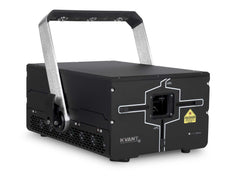
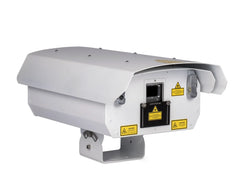


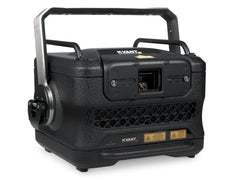
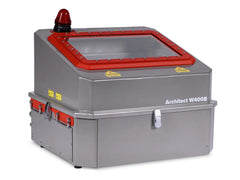
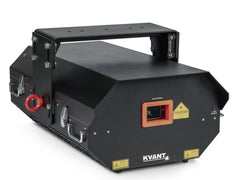


 OSC
OSC